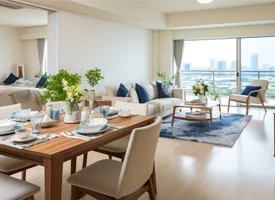Being an architect, I get really happy and excited when I see people asking questions like this since not many people know about
daylight architecture or complex architecture or construction terms like this.
More than merely installing skylights or panels to a space qualifies as daylighting. It involves a careful balancing of heat intake and loss together with glare management and varying sunshine availability. I will explain to you daylight architecture in straightforward words here.
Get in touch with the professional interior designers of NoBroker to understand your home’s requirement for daylight architecture.What is daylight factor?
The science and art of daylighting revolve around how to give a populated room enough natural light without having any unfavourable side effects. The key to effective daylighting is the use of shade equipment to lower excessive contrast and brightness in the workspace. The quantity of natural light in space is referred to as the "daylight factor" in architecture. It is expressed as a ratio of the amount of light present inside the building to the amount of light present outside the building (indoor light/outside light).
The daylight component of a facility is important to its occupants' occupational health since prolonged exposure to some types of artificial lighting, like those found in many office buildings, can have detrimental effects.
Components of daylight architecture
The daylight factor is calculated as the total of the three factors:
DF = SC + ERC + IRCSC – Sky Component
ERC – Externally Reflected Component
IRC – Internally Reflected Component
Sky component, or daylight accessible under an unobstructed sky, is the proportion of daylight descending on vertical walls to the daylight that is directly from the sky. The sky is not typically used to represent direct sunlight; instead, it alludes to the dispersed sky.
To put it another way, it can be defined as the ratio (or percentage) between the portion of the daylight illumination at a given location on a given plane that is directly obtained from the sky and the simultaneous exterior illumination on a flat directly from the entire segment of an unimpeded clear design sky.
External Reflected Component (ERC):The outwardly reflecting element is the sunlight that is reflected off a building or wall and then enters the area under consideration (ERC). In other terms, it is the proportion (or percentage) of the daylight luminous flux at a given place on a plane that is reflected directly off outside surfaces to the contemporaneous external luminous intensity in a flat directly from the full hemisphere of an unimpeded clear blue sky.
Internal Reflected Component (IRC):The typical internally reflected portion of the daylight factor is the amount of daylight that, following reflections and interreflections from surfaces inside the room, reaches a reference point. The amount of cross-reflection light will vary across the space, but for the majority of purposes, calculating an overall average to provide to the majority of the space and a minimum for locations far from the window would suffice.
In other phrases, it is the proportion of the exterior illumination on a horizontal plane caused by the entire segment of an unimpeded clear design sky to the portion of the daylight illumination at a juncture in a particular plane that is obtained by perfect reflection or cross-reflection from the internal surfaces.
This is all you need to know about daylight architecture to understand its concept of it.
Read More: What is a skylight window? How to install skylight on roof? What is Vernacular Architecture Meaning and Features? What is Gothic Architecture Features and Origin?Your Feedback Matters! How was this Answer?
Make Every Corner of Your Home Festive Ready !
✔
Trained & Experienced Partners✔
Best Prices✔
Quality Assurance
Home Painting
Get Free Estimate

Home Cleaning
Book Now

Home Renovation
Get Free Quote

Electrician Services
Book Now
Related Questions
Leave an answer
You must login or register to add a new answer .









What is Daylight Factor?
Taani
589 Views
1
2 Year
2022-09-19T19:06:16+00:00 2022-09-19T19:06:18+00:00Comment
Share